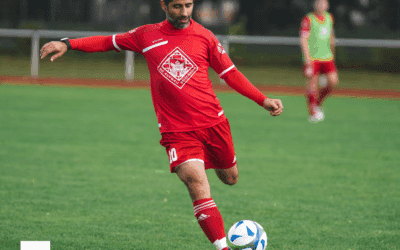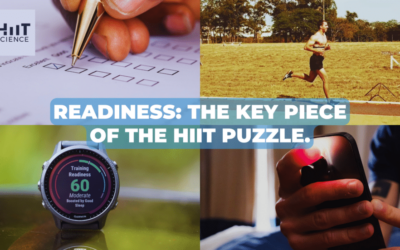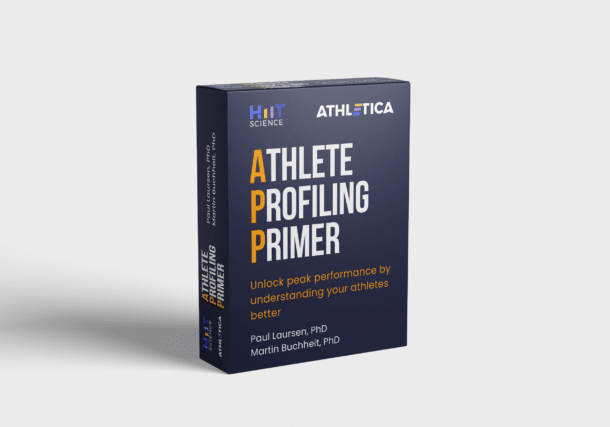Sport description and running demands
Gaelic football is one of the national sports of Ireland (1, 2). The sport is played both on an intra- and inter-county basis among the counties of Ireland (6, 7, 9).Match-play consists of two teams of 15 players composed of a goalkeeper, three full-backs, three half-backs, two midfielders, three half-forwards, and three full-forwards (Figure 1).A score is recorded when the ball is kicked or hand-passed over the crossbar, which is worth one point, or when a goal is scored by kicking or palming the ball into the net below the crossbar (3 points) (9). Ultimately, the primary objective for each team is to outscore their direct opponent during match-play, by moving the ball skilfully by hand or foot during attacking, as well as defending their opponent’s plays, across a duration of 60-70 min, plus additional time (due to stoppages) depending on the level of competition (underage, senior, club, county) (7, 9).

Figure 1. The Gaelic football playing field, dimensions, and playing positions during match-play.
Determining the importance of running performance to Gaelic football match-play outcome is difficult. This is due to myriad complex interactions during match-play and contextual factors.
Typically, elite Gaelic football players have been reported to run between 8 and 9 km during a competitive match (2, 3, 4, 5, 6).
Due to the intermittent nature of Gaelic football, players will run about 1.7 km at high speed (≥17 km·h-1) (2, 3, 4, 7, 8) (Table 1). TThese running performance demands tend to be highest for half-backs, midfield, and half-forward players (2, 3, 4, 5, 6, 8), with an increase or decrease in demands depending on divisional status (8) and the time of the season (6). In addition, total distance and high-speed distance covered in match-play have been shown to significantly decrease across quarters of play (3, 5).
These demands need to be understood by coaches within an ergonomic model of training to best piece together their program in order for players to perform during competition.
Gaelic football coaches need to appreciate that player’s fitness levels must meet the demands of their direct opposition during match-play, while effectively being able to execute their positional technical and tactical roles, and as such fulfilling the specific game-plan of the coaching team.
Video 1. Representation of a kick-out set play resulting in a Goal within elite Gaelic football, showing competition for possession, off the ball running and execution of key fundamental skills of the game.

Table 1. The positional match-play running performance of elite Gaelic football across halves of play. Table reprinted with permission from Malone et al., 2016 (2).
Physiological Profile of Gaelic Football
While a high degree of focus has been placed on external load monitoring through GPS (running demands) within Gaelic football, over recent years, the development of aerobic power and internal objective monitoring has been advanced. Research has shown that players during match play actions attain 80-90% of heart rate max (HRmax) with an average of 85% HRmax (1, 10).These internal load demands need to be understood to best develop a performance program that can allow players to execute the skills of the game during the most intense physiologically demanding periods of match-play within training segments.Additionally, within the literature it has been shown that increased aerobic power reduces injury risk (11) within Gaelic football players, but also allows players to recover quicker between repeated bouts of running. While it is not possible to delve into detail within the current blog, the monitoring of objective internal loading with HR monitoring has an important impact on the ability of coaches to understand the specific dose-response relationship between their training content and changes in the fitness-fatigue relationship for these players (12).
Conclusion
To appropriately prepare Gaelic football players to express their talents within match-play, strength and conditioning staff need to appreciate the myriad performance requirements of players during match-play. The physical, physiological-tactical, and technical requirements will change, depending on the position played, a coaches’ tactical setup, the direct opposition, divisional status, competition played, as well as the time of the season — to name only a few contextual factors. Coaches need to realise that there are multiple HIIT targets that can be utilised to prepare a team for competition. In the forthcoming blog post, we will delve deeper into some specific HIIT targets for Gaelic football players, as well as the weapons we deploy to hit these targets.About the authors
 Shane Malone is the current sport scientist for the Dublin senior football team. He also lectures on the Sports Science and health course in TU Dublin. Shane has published numerous manuscripts within team sports across topics such as training load, small-sided games, dose-response, training demands and match demands, with much of this research based within Gaelic Football and Hurling. He has also consulted with many team sport organisations on training methodologies to improve physical capacities. Follow him on twitter @shanemalone01.
Shane Malone is the current sport scientist for the Dublin senior football team. He also lectures on the Sports Science and health course in TU Dublin. Shane has published numerous manuscripts within team sports across topics such as training load, small-sided games, dose-response, training demands and match demands, with much of this research based within Gaelic Football and Hurling. He has also consulted with many team sport organisations on training methodologies to improve physical capacities. Follow him on twitter @shanemalone01.
 Bryan Cullen is the current high-performance manager at Dublin GAA. He has completed a PhD in applied sport science through Dublin City University analysing the physical characteristics and running performance of underage Gaelic football players. Bryan has published several manuscripts analysing the physical characteristics, training load and match play running demands within underage and senior Gaelic football. He also currently lectures on the Sports Science and Health programme at DCU across several modules.Follow him on twitter @bryancullen.
Bryan Cullen is the current high-performance manager at Dublin GAA. He has completed a PhD in applied sport science through Dublin City University analysing the physical characteristics and running performance of underage Gaelic football players. Bryan has published several manuscripts analysing the physical characteristics, training load and match play running demands within underage and senior Gaelic football. He also currently lectures on the Sports Science and Health programme at DCU across several modules.Follow him on twitter @bryancullen.
References
- Cullen B, Roantree MT, McCarren AL et al. Physiological profile and activity patter of Minor Gaelic football Players. J Strength Cond Res. 2017. 31(7): 1881-1820.
- Malone, S, Solan B, Collins DK, Doran DA. The positional match running performance of elite Gaelic football. J Strength Cond Res. 2016. 30(8): 2292-2298
- Malone S, Solan B, Collins K, Doran D. The metabolic power and energetic demands of elite Gaelic football match-play. J Sport Med Phys Fitness. 2017. 57(5): 543-549.
- Malone S, Solan B, Hughes B, Collins K. Duration specific running performance in elite Gaelic football. 2017. EPub Ahead of Print. doi: 10.1519/JSC.0000000000001972.
- Malone S, Solan B, Collins K. The running performance profile of elite Gaelic football match-play. J Strength Cond Res. 2017. 31(1): 30-36
- Mangan S, Ryan M, Shovlin A, et al. Seasonal Changes in Gaelic football Match-Play running performance. J Strength Cond Res. 2019. 33(6): 1685-1691.
- Mangan S, Malone S, Ryan M. et al. Influence of Team Rating on running performance in elite Gaelic football. J Strength Cond Res 2018. 32(9): 2584-2591.
- McGahan JH, Mangan S, Collins K. et al. Match-play running demands and technical performance among elite Gaelic footballers: Does divisional status count? J Strength Cond Res. 2018. EPub Ahead of Print. doi: 10.1519/JSC.0000000000002450
- Reilly T, Collins K. Science and the Gaelic sports: Gaelic football and Hurling. Eur J Sport Sci 2008. 8(5): 231-240.
- Florida-James G, Reilly T. The physiological demands of Gaelic Football. Br J Sports Med 1995. 29(1): 41-45.
- Malone S, Roe M, Doran DA, Gabbett TJ, Collins KD. Protection Against Spikes in Workload With Aerobic Fitness and Playing Experience: The Role of the Acute:Chronic Workload Ratio on Injury Risk in Elite Gaelic Football. Int J Sports Physiol Perform 2017. 12(3):393-401.
- Akubat I, Patel E, Barrett S, At G. Methods of monitoring the training and match load and their relationship to changes in fitness in professional youth soccer players J Sports Sci 30(14):1473-80.






